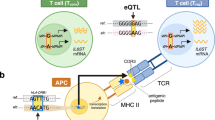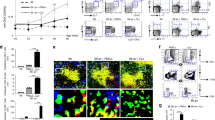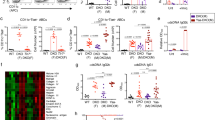Abstract
The F1 hybrid of autoimmune hemolytic anemia-prone NZB and nonautoimmune NZW strains of mice has been studied as a murine model of systemic lupus erythematosus. Both NZB and F1 hybrid mice show age-dependent spontaneous activation of peripheral CD4+ T cells as reflected by the elevated frequencies of CD4+ T cells positive for CD69 early activation marker. Both strains also show age-dependent abnormal decrease of the frequencies of CD62L+ naive CD4+ T cells and/or NTA260+ memory CD4+ T cells in the spleen. We studied the multigenic control of these abnormal features of peripheral CD4+ T cells in (NZB × NZW) F1 × NZW backcross mice by quantitative trait loci mapping and by association rule analysis. The abnormally elevated frequencies of CD69+CD4+ T cells and decreased frequencies of CD62L+ naive and/or NTA260+ memory CD4+ T cells were under the common genetic control, in which the interaction between MHC and a hitherto unknown locus, designated Sta-1 (spontaneous T-cell activation) on chromosome 12, plays a major role. The allelic effects of these loci likely predispose CD4+ T cells to the loss of self-tolerance, and are responsible for the accelerated autoimmune phenotypes of (NZB × NZW) F1 hybrid mice.
This is a preview of subscription content, access via your institution
Access options
Subscribe to this journal
Receive 6 digital issues and online access to articles
$119.00 per year
only $19.83 per issue
Buy this article
- Purchase on Springer Link
- Instant access to full article PDF
Prices may be subject to local taxes which are calculated during checkout




Similar content being viewed by others
References
Bielschowsky M, Helyer BJ, Howie JB . Spontaneous haemolytic anemia in mice of the NZB/B1 strain. Proc Univ Otago Med Sch 1959; 37: 9–11.
Helyer BJ, Howie JB . Renal disease associated with positive lupus erythematosus tests in a cross-bred strain of mice. Nature 1963; 197: 197.
Shirai T, Hirose S, Okada T, Nishimura H . Immunology and immunopathology of the autoimmune disease of NZB and related mouse strains. In: Rihova B, Vetvicka V (eds). Immunological Disorders in Mice. CRC Press: Boca Raton, FL, 1991, pp 96–136.
Kelley VE, Winkelstein A . Age- and sex-related glomerulonephritis in New Zealand white mice. Clin Immunol Immunopathol 1980; 16: 142–150.
Theofilopoulos AN, Dixon FJ . Murine models of systemic lupus erythematosus. Adv Immunol 1985; 37: 269–390.
Hayakawa K, Hardy RR, Parks DR, Herzenberg LA . The ‘Ly-1 B’ cell subpopulation in normal, immunodefective, and autoimmune mice. J Exp Med 1983; 157: 202–218.
Herzenberg LA, Stall AM, Lalor PA, Sidman C, Moore WA, Parks DR et al. The Ly-1 B cell lineage. Immunol Rev 1986; 93: 81–102.
Hirose S, Jiang Y, Hamano Y, Shirai T . Genetic aspects of inherent B-cell abnormalities associated with SLE and B-cell malignancy: lessons from New Zealand mouse models. Int Rev Immunol 2000; 19: 389–421.
Hirose S, Nagasawa R, Sekigawa I, Hamaoki M, Ishida Y, Sato H et al. Enhancing effect of H-2-linked NZW gene(s) on the autoimmune traits of (NZB × NZW) F1 mice. J Exp Med 1983; 158: 228–233.
Hirose S, Ueda G, Noguchi K, Okada T, Sekigawa I, Sato H et al. Requirement of H-2 heterozygosity for autoimmunity in (NZB × NZW) F1 hybrid mice. Eur J Immunol 1986; 16: 1631–1633.
Taki S, Hirose S, Kinoshita K, Nishimura H, Shimamura T, Hamuro J et al. Somatically mutated IgG anti-DNA antibody clonally related to germ-line encoded IgM anti-DNA antibody. Eur J Immunol 1992; 22: 987–992.
Hirose S, Wakiya M, Kawano-Nishi Y, Yi J, Sanokawa R, Taki S et al. Somatic diversification and affinity maturation of IgM and IgG anti-DNA antibodies in murine lupus. Eur J Immunol 1993; 23: 2813–2820.
Tokushima M, Koarada S, Hirose S, Gotoh Y, Nishimura H, Shirai T et al. In vivo induction of IgG anti-DNA antibody by autoreactive mixed haplotype Aβz/AαdMHC class II molecule-specific CD4+ T-cell clones. Immunology 1994; 83: 221–226.
Ishikawa S, Akakura S, Abe M, Terashima K, Chijiiwa K, Nishimura H et al. A subset of CD4+ T cells expressing early activation antigen CD69 in murine lupus: Possible abnormal regulatory role for cytokine imbalance. J Immunol 1998; 161: 1267–1273.
Ohgaki M, Ueda G, Shiota J, Nishimura H, Hirose S, Sato H et al. Two distinct monoclonal natural thymocytotoxic autoantibodies from New Zealand black mouse. Clin Immunol Immunopathol 1989; 53: 475–487.
Nishimura H, Hattori S, Ueda G, Abe M, Yang K, Nozawa S et al. Functional CD4+ T cell subsets defined by expression of CD45RC and NTA260 antigens and age-associated polarization in murine lupus. Int Immunol 1995; 7: 1115–1123.
Alcocer-Varela J, Alarcon-Segovia D . Decreased production of and response to interleukin-2 by cultured lymphocytes from patients with systemic lupus erythematosus. J Clin Invest 1982; 69: 1388–1392.
Linker-Israeli M, Bakke AC, Kitridou RC, Gendler S, Gillis S, Horwitz DA . Defective production of interleukin 1 and interleukin 2 in patients with systemic lupus erythematosus (SLE). J Immunol 1983; 130: 2651–2655.
Murakawa Y, Takada S, Ueda Y, Suzuki N, Hoshino T, Sakane T . Characterization of T lymphocyte subpopulations responsible for deficient interleukin 2 activity in patients with systemic lupus erythematosus. J Immunol 1985; 134: 187–195.
Huang Y-P, Miescher PA, Zubler RH . The interleukin 2 secretion defect in vitro in systemic lupus erythematosus is reversible in restricted cultured T cells. J Immunol 1986; 137: 3515–3520.
Raziuddin S, Danial HB, Kelley M . OKT4+ T cell abnormality in patients with active systemic lupus erythematosus: HLA-DR antigen expressions. Clin Immunol Immunopathol 1988; 48: 42–49.
Spronk PE, Horst G, Van der Gun BTF, Limburg PC, Kallenberg CGM . Anti-dsDNA production coincides with concurrent B and T cell activation during development of active disease in systemic lupus erythematosus (SLE). Clin Exp Immunol 1996; 104: 446–453.
Hishikawa T, Tokano Y, Sekigawa I, Ando S, Takasaki Y, Hashimoto H et al. HLA-DP+ T cells and deficient interleukin-2 production in patients with systemic lupus erythematosus. Clin Immunol Immunopathol 1990; 55: 285–296.
Viallard FJ, Bloch-Michel C, Neau-Cransac M, Taupin JL, Garrigue V, Miossec V et al. HLA-DR expression on lymphocyte subsets as a marker of disease activity in patients with systemic lupus erythematosus. Clin Exp Immunol 2001; 125: 485–491.
Morimoto C, Reinherz EL, Distaso JA, Steinberg AD, Schlossman SF . Relationship between systemic lupus erythematosus T cell subsets, anti-T cell antibodies, and T cell functions. J Clin Invest 1984; 73: 689–700.
Sato K, Miyasaka N, Yamaoka K, Okuda M, Yata J, Nishioka K . Quantitative defect of CD4+2H4+ cells in systemic lupus erythematosus and Sjogren's syndrome. Arthritis Rheum 1987; 30: 1407–1411.
Imhof B, Dunon D . Leukocyte migration and adhesion. Adv Immunol 1995; 58: 345–416.
Otto J . Analysis of human genetic linkage, 3rd edn. The Johns Hopkins University Press: Baltimore, MD, 1999, pp 280–291.
Manly KF, Olson JM . Overview of QTL mapping software and introduction to map manager QT. Mamm Genome 1999; 10: 327–334.
Lander E, Kruglyak L . Genetic dissection of complex traits: guidelines for interpreting and reporting linkage results. Nat Genet 1995; 11: 241–247.
Wofsy D, Seaman WE . Successful treatment of autoimmunity in NZB/NZW F1 mice with monoclonal antibody to L3T4. J Exp Med 1985; 161: 378–391.
Sekigawa I, Ishida Y, Hirose S, Sato H, Shirai T . Cellular basis of in vitro anti-DNA antibody production: evidence for T cell dependence of IgG-class anti-DNA antibody synthesis in the (NZB × NZW)F1 hybrid. J Immunol 1986; 136: 1247–1252.
Sekigawa I, Okada T, Noguchi K, Ueda G, Hirose S, Sato H et al. Class-specific regulation of anti-DNA antibody synthesis and the age-associated changes in (NZB × NZW) F1 hybrid mice. J Immunol 1987; 138: 2890–2895.
Nishimura H, Ishikawa S, Nozawa S, Awaji M, Saito J, Abe M et al. Effects of transgenic mixed-haplotype MHC class II molecules AαdAβz on autoimmune disease in New Zealand mice. Int Immunol 1996; 8: 967–976.
Zhang D, Fujio K, Jiang Y, Zhao J, Tada N, Sudo K et al. Dissection of the role of MHC class II A and E genes in autoimmune susceptibility in murine lupus models with intragenic recombination. Proc Natl Acad Sci USA 2004; 101: 13838–13843.
Graham RR, Ortmann WA, Langefeld CD, Jawaheer D, Selby SA, Rodine PR et al. Visualizing human leukocyte antigen class II risk haplotypes in human systemic lupus erythematosus. Am J Hum Genet 2002; 71: 543–553.
Quayle A, Kieldsen-Kragh J, Forre O, Waalen K, Sioud M, Kalvenes C et al. Immunoregulatory T cell subsets and T cell activation in rheumatoid arthritis. A need for analysis on the clonal and molecular level. Springer Semin Immunopathol 1989; 11: 273–287.
Fox RI, Howell FV, Bone RC, Micheloson P . Primary Sjogren syndrome: clinical and immunopathologic feature. Semin Arthritis Rheum 1984; 14: 77–105.
Tokushige K, Hirose S, Nishimura H, Fujimori M, Yamauchi K, Obata H et al. Abnormal T cell activation and skewed T cell receptor V β repertoire usage in Japanese patients with idiopathic portal hypertension. Clin Immunol Immunopathol 1995; 75: 206–213.
Bolland S, Ravetch JV . Spontaneous autoimmune disease in FcγRIIB-deficient mice results from strain-specific epistasis. Immunity 2000; 13: 277–285.
Bolland S, Yim YS, Tus K, Wakeland EK, Ravetch JV . Genetic modifiers of systemic lupus erythematosus in FcγRIIB(−/−) mice. J Exp Med 2002; 195: 1167–1174.
Fukuyama H, Nimmerjahn F, Ravetch JV . The inhibitory Fc gamma receptor modulates autoimmunity by limiting the accumulation of immunoglobulin G+ anti-DNA plasma cells. Nat Immunol 2005; 6: 99–106.
Jiang Y, Hirose S, Sanokawa-Akakura R, Abe M, Mi X, Li N et al. Genetically determined aberrant down-regulation of FcγRIIB1 in germinal center B cells associated with hyper-IgG and IgG autoantibodies in murine systemic lupus erythematosus. Int Immunol 1999; 11: 1685–1691.
Jiang Y, Hirose S, Abe M, Sanokawa-Akakura R, Ohtsuji M, Mi X et al. Polymorphisms in IgG Fc receptor IIB regulatory regions associated with autoimmune susceptibility. Immunogenetics 2000; 51: 429–435.
Xiu Y, Nakamura K, Abe M, Li N, Wen XS, Jiang Y et al. Transcriptional regulation of Fcgr2b gene by polymorphic promoter region and its contribution to humoral immune responses. J Immunol 2002; 169: 4340–4346.
Rigby RJ, Rozzo SJ, Boyle J, Lewis M, Kotzin BL, Vyse TJ . New loci from New Zealand Black and New Zealand White on chromosome 4 and 12 contribute to lupus-like disease in the context of BALB/c. J Immunol 2004; 172: 4609–4617.
Krulova M, Havelkova H, Kosarova M, Holan V, Hart AA, Demant P et al. IL-2-induced proliferative response is controlled by loci Cinda1 and Cinda2 on mouse chromosomes 11 and 12: a distinct control of the response induced by different IL-2 concentrations. Genomics 1997; 42: 11–15.
Nagase H, Mao JH, Balmain A . A subset of skin tumor modifier loci determines survival time of tumor-bearing mice. Proc Natl Acad Sci USA 1999; 96: 15032–15037.
Jackson AU, Galeck AT, Burke DT, Miller RA . Genetic polymorphisms in mouse genes regulating age-sensitive and age-stable Tcell subsets. Genes Immun 2003; 4: 30–39.
Shiow LR, Rosen DB, Brdickova N, Xu Y, An J, Lanier LL et al. CD69 acts downstream of interferon-alpha/beta to inhibit S1P1 and lymphocyte egress from lymphoid organs. Nature 2006; 440: 540–544.
Baechler EC, Gregersen PK, Behrens TW . The emerging role of interferon in human systemic lupus erythematosus. Curr Opin Immunol 2004; 16: 801–807.
Sambrook J, Fritsch EF, Maniatis T . Isolation of high-molecular-weight DNA from mammalian cells. In: Ford N, Nora C, Ferguson M (eds). Molecular Cloning: A Laboratory Manual. Cold Spring Harbor Laboratory Press: Cold Spring Harbor, NY, 1989, pp 9–14.
Dietrich W, Katz H, Lincoln SE, Shin HS, Friedman J, Dracopoli NC et al. A genetic map of the mouse suitable for typing intraspecific crosses. Genetics 1992; 131: 423–447.
Ogasawara M, Sugimori H, Iida Y, Yoshida K . Analysis between lifestyle, family medical history and medical abnormalities using data mining method – association rule analysis. In: Khosla R, Howlett RJ, Jain LC (eds). Knowledge-Based Intelligent Information and Engineering Systems, 9th International Conference, KES 2005, Melbourne, Australia, 14–16 September, 2005, Proceedings, Part II, Lecture Notes in Artificial Intelligence (Subseries of Lecture Notes in Computer Science), Vol. 3682. Springer-Verlag: New York, NY, 2005, pp 161–171.
Agrawal R, Imielinski T, Swami A . Mining association rules between sets of items in large databases. ACM SIGMOD 1993; 22: 207–216.
Acknowledgements
This work is supported by a Grant-in-Aid from the Ministry of Education, Science and Culture, Japan. We thank Noriko Isoyama and Atsuko Kusano for the management of the mouse colonies and Noriko Iida for technical assistance.
Author information
Authors and Affiliations
Corresponding author
Rights and permissions
About this article
Cite this article
Fujii, T., Iida, Y., Yomogida, M. et al. Genetic control of the spontaneous activation of CD4+ Th cells in systemic lupus erythematosus-prone (NZB × NZW) F1 mice. Genes Immun 7, 647–654 (2006). https://doi.org/10.1038/sj.gene.6364342
Received:
Revised:
Accepted:
Published:
Issue Date:
DOI: https://doi.org/10.1038/sj.gene.6364342



